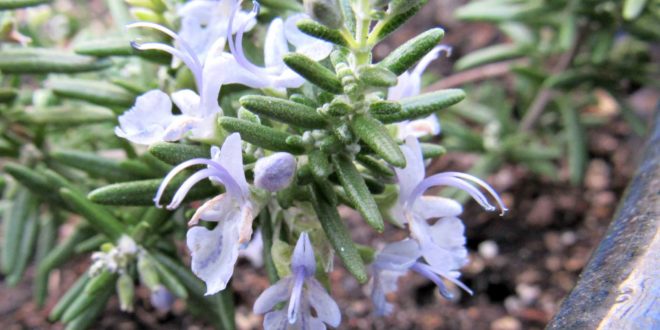Rosemary is one of those wonderful herbs that makes a beautiful ornamental plant as well as a welcome culinary seasoning to your Sunnyvale garden. Its Latin name, Rosmarinus officinalis , means “dew of the sea” and rosemary is most closely associated with the cooking of the Mediterranean area. However you don’t need perfect sunshine, sea mist or even a never ending summer to successfully grow rosemary. In fact, more rosemary plants suffer from too much attention than from too little.
There are several varieties of rosemary, the most common being Upright or Creeping. If you want to use rosemary stems as kabob skewers then get the Upright variety. Otherwise the two varieties taste the same. Rosemary makes great landscape plants. They have year-round evergreen foliage and are often colored with blue flowers. You can grow them in hanging baskets (for the Creeping variety); pots (Upright or Creeping); or in the ground (Upright or Creeping).
Starting a Rosemary Plant
Rosemary is usually propagated by cuttings. Seeds can be difficult to germinate and often don’t grow true to their parent. It’s much faster to start with a cutting and you will be sure of what type of plant you will get. It’s possible to root rosemary in a glass of water, but a bit more effort will give more dependable results.
Snip about a 2 inch cutting from the soft, new growth of an established plant.
Remove the leaves from the bottom inch and dip that tip into a rooting hormone. Rooting hormones can be found in any garden center.
Carefully place the dipped end into a container of dampened, sterile seed starting mix. Choose a mix that says it is well draining, like something containing peat moss with vermiculite or perlite.
Place the container in a warm spot with indirect sunlight.
Mist the cuttings daily and make sure the soil does not dry out.
In about 2-3 weeks, test for root growth by very gently tugging on the cuttings.
Once your cuttings have roots, transplant into individual pots about 3-4 inches in diameter.
Pinch off the very top of the cutting to encourage it to develop branches.
Begin caring for your cutting as a rosemary plant.
Growing and Caring for Rosemary Plants
The three fundamentals for successfully growing rosemary are: Sun, Good Drainage and Good Air Circulation.
If you live in a frost free area, you can grow rosemary in the ground year round. Provide a sandy, well draining soil and 6-8 hours of full sunlight.
Rosemary is not a heavy feeder, but fertilizing in spring with a fish/kelp emulsion will get it off to a good start for the season. Periodic foliar sprays with the emulsion will keep it looking great.
Bringing Rosemary Indoors
Where the winter temperatures dip below 30 degrees F., rosemary plants will have to spend the winter indoors. In this case, it’s easier to grow your rosemary in a container all year. Since rosemary likes it on the dry side, terra cotta pots are an especially good choice. Just be sure it doesn’t bake and completely dry out while outdoors during the summer.
Bring the potted rosemary inside once the temperature inches into the 30s. It can be a little trickier to keep rosemary happy inside. Your rosemary plant will still require 6-8 hours of full sun, so artificial lights may be necessary. Heat is not as crucial as sunlight.
Pests and Problems of Rosemary Plants
The biggest problem with growing rosemary indoors is its tendency to get powdery mildew. Powdery mildew is a white, powdery fungus that can develop if the surrounding air is humid and there is not enough air movement.
Powdery mildew won’t kill your rosemary, but it will weaken the plant. Keep the humidity low by allowing the soil to dry somewhat between waterings, keeping the plant in sunlight and, if necessary, running a fan for a few hours a day to create a breeze.
Also be on the lookout for aphids and spider mites. These pests seem to live on houseplants for the winter. Catching them before a total infestation will make them easier to control. Repeated spraying with insecticidal soap, per package directions, should take care of the problem.
Maintaining a Potted Rosemary
Move your potted rosemary back outdoors once all danger of frost has passed.
As with most potted plants, the soil in your rosemary pot will degenerate through watering and root growth. Repot at least once a year. Spring is a good time to repot your rosemary, but it should be fine no matter what time of year you get to it.
When the rosemary plant puts out considerable growth or looks like it just can’t get enough water, it has outgrown its pot and needs to be transplanted into a larger one. If you want to maintain the size of your rosemary plant, root prune it by slicing off a couple of inches of the roots from the bottom and sides of the root ball and replanting in the same pot. Be sure to trim some of the top at the same time, to lessen the work load of the roots and the stress placed upon the trimmed plant. Then allow your repotted plant some time to regroup. It should reward you with many more seasons of snippings.
Great rosemary choices for growing and cooking.








